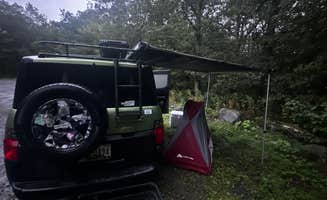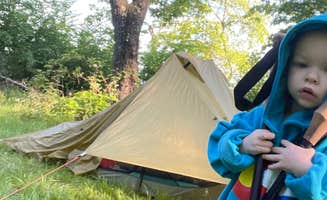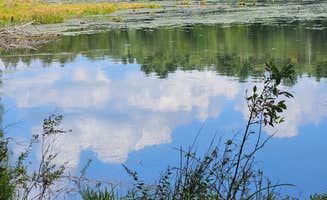Dispersed camping near Thornhurst, Pennsylvania provides access to the Delaware State Forest, which encompasses over 83,000 acres of mixed hardwood forests and wetlands. The region sits at elevations between 1,300-1,800 feet, creating cooler summer temperatures than surrounding lowlands. Winter camping requires additional preparation as snowfall typically begins in November and can persist through early April, with nighttime temperatures regularly dropping below freezing.
What to do
Hiking to viewpoints: The Appalachian Trail offers multiple elevated vistas within day-hiking distance from camping areas. At Bake Oven Knob, camper Dani T. notes, "The hike to the overlook is really lovely; short and rocky." Most viewpoints require moderate hiking over rocky terrain.
Fishing opportunities: Several small lakes and streams support bass and trout fishing, subject to Pennsylvania fishing regulations. Seasonal restrictions apply, with most waters open from April through October. At Hickok Brook, the lakeside tent sites provide direct water access, though Corey warns the area is "beautiful but buggy."
Wildlife observation: The forests support diverse wildlife including white-tailed deer, black bears, and numerous bird species. Early morning and dusk provide optimal viewing times. Bring binoculars and maintain proper food storage. Jason R. from Thunder Swamp Trailhead mentions, "Went down Saw Creek trail to a marsh," an excellent location for wildlife spotting.
What campers like
Natural separation between sites: The dispersed nature of camping areas provides natural buffers between campers. Katharine T. at Appalachian Trail Designated Backpacker Campsite appreciates that "There's plenty of space. We camped nearer to others but there are secluded spots too."
Accessibility for various experience levels: Some sites accommodate both novice and experienced campers. Thunder Swamp Trailhead offers a gentle introduction to dispersed camping, with Benjamin H. noting, "It's a gravel parking lot. Plenty of shade. No one bothered me."
Hammock-friendly terrain: The abundant tree coverage makes the area ideal for hammock camping, particularly on sloped terrain where tent placement proves difficult. At Appalachian Trail Designated Backpacker Campsite 2, Katharine T. confirms there are "Good trees for hammocking."
What you should know
Limited facilities: Most dispersed camping sites have no drinking water, toilets, or trash collection. Pack out all waste and bring sufficient water. Renee Z. cautions about Appalachian Trail sites: "I gave the site only four stars because there's no water nearby."
Permit requirements: Some areas require camping permits, obtained through ranger stations or online systems. At Hickok Brook, Gregg T. advises, "Need a permit on NY state land. Contact Rangers office of whatever county."
Seasonal considerations: Spring brings muddy conditions, summer increases competition for sites, fall offers colorful foliage but colder nights, and winter requires cold-weather gear. Sites fill quickly on holidays, with Gregg T. observing at Hickok Brook, "It's Labor Day weekend, see how many people try to cram into the very limited camping area."
Tips for camping with families
Site selection priorities: Choose areas with level ground and natural boundaries for child safety. Spots with natural features like small clearings work best for family tents and activities.
Water planning: No reliable water sources exist at most sites, requiring families to bring 1-2 gallons per person per day. For longer stays, research water resupply options in nearby towns, typically 10-15 miles from camping areas.
Safety considerations: Cell service ranges from limited to non-existent in many areas. Bring physical maps and first aid supplies. Dani T. from Bake Oven Knob points out that while overlooks offer views, the trails can be "short and rocky," requiring proper footwear for children.
Tips from RVers
Vehicle requirements: Many access roads demand high-clearance vehicles. Corey from Hickok Brook cautions: "The road is very rough with huge potholes so good clearance is a must. It's not a good spot for car camping."
Limited turn-around space: Most forest roads near Thornhurst lack designated turning areas for larger vehicles. Scout potential sites before attempting access with trailers or larger RVs.
Overnight parking options: Some trailheads permit overnight vehicle parking. Jason R. found that "Trailhead parking was chill for a night. No trouble" at Thunder Swamp Trailhead, making it suitable for van camping or as a base for backpacking excursions.




